Analysis of Decentralization and Performance Measurement Strategies
VerifiedAdded on 2023/06/15
|7
|1279
|111
Essay
AI Summary
This essay explores the concepts of decentralization and performance measurement within organizations. It defines decentralization as the transfer of decision-making power and accountability, highlighting its advantages such as improved decision quality and diversification of activities, as well as disadvantages like potential misalignment of goals and lack of holistic understanding at lower management levels. The essay also discusses various performance measurement methods, including 360-degree evaluation, graphic rating scales, and management by objectives, with a focus on the balanced scorecard approach. The balanced scorecard's benefits in implementing strategy, addressing intangible assets, and enhancing performance measurement are emphasized using the example of Nestle Company in UAE. The essay concludes that while decentralization has both advantages and disadvantages, effective management and regular performance measurement are crucial for achieving organizational goals. Desklib provides access to similar essays and study resources for students.
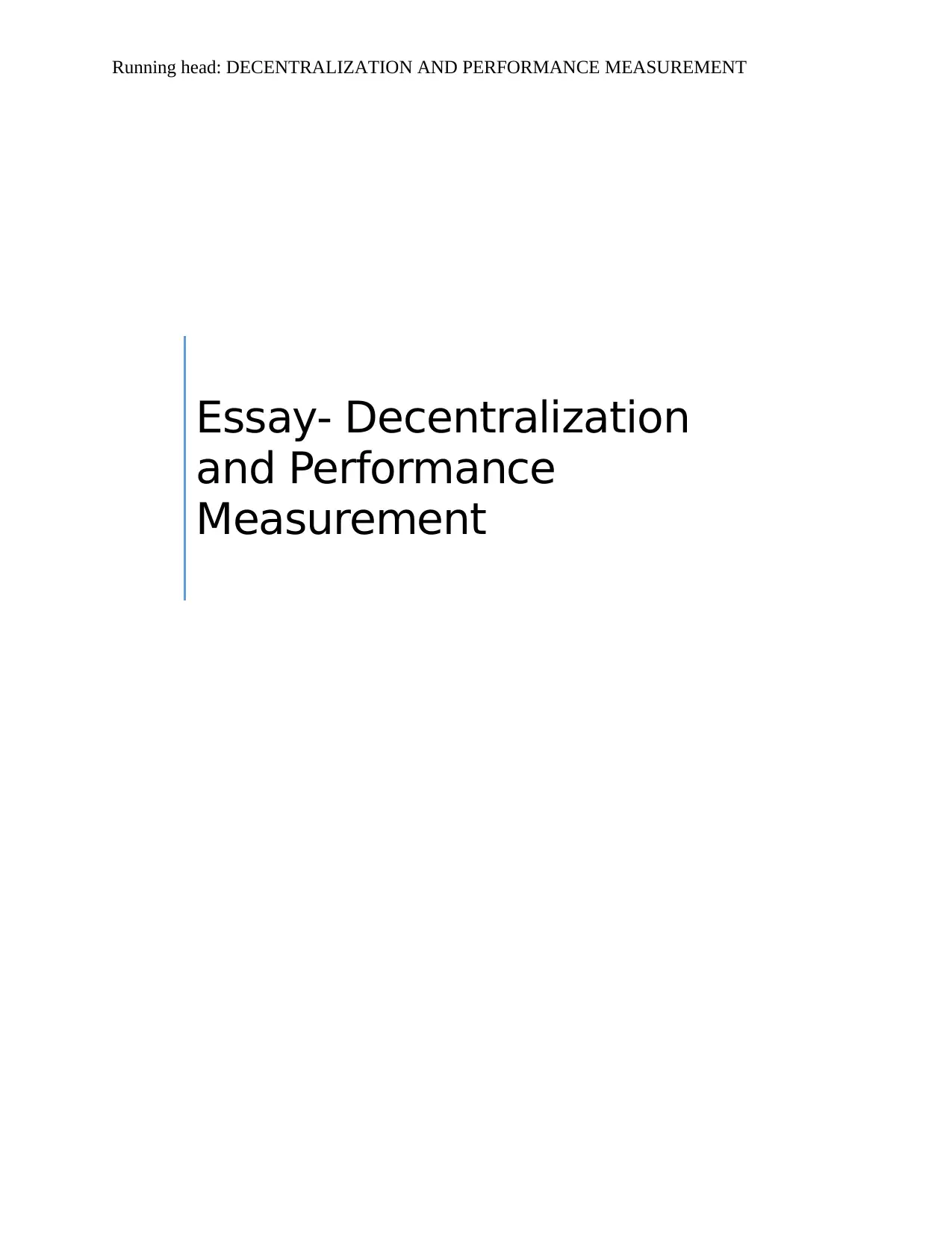
Running head: DECENTRALIZATION AND PERFORMANCE MEASUREMENT
Essay- Decentralization
and Performance
Measurement
Essay- Decentralization
and Performance
Measurement
Paraphrase This Document
Need a fresh take? Get an instant paraphrase of this document with our AI Paraphraser
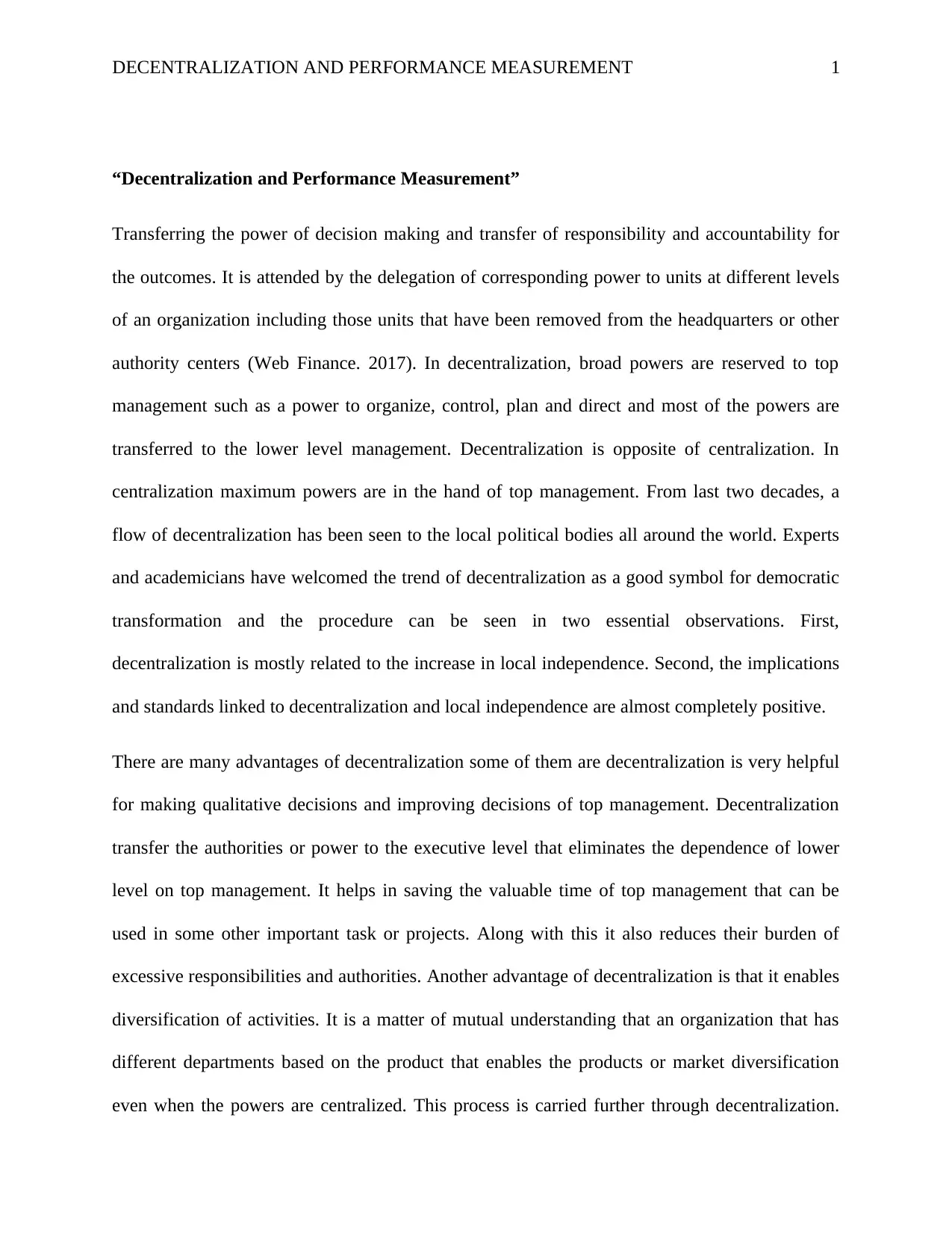
DECENTRALIZATION AND PERFORMANCE MEASUREMENT 1
“Decentralization and Performance Measurement”
Transferring the power of decision making and transfer of responsibility and accountability for
the outcomes. It is attended by the delegation of corresponding power to units at different levels
of an organization including those units that have been removed from the headquarters or other
authority centers (Web Finance. 2017). In decentralization, broad powers are reserved to top
management such as a power to organize, control, plan and direct and most of the powers are
transferred to the lower level management. Decentralization is opposite of centralization. In
centralization maximum powers are in the hand of top management. From last two decades, a
flow of decentralization has been seen to the local political bodies all around the world. Experts
and academicians have welcomed the trend of decentralization as a good symbol for democratic
transformation and the procedure can be seen in two essential observations. First,
decentralization is mostly related to the increase in local independence. Second, the implications
and standards linked to decentralization and local independence are almost completely positive.
There are many advantages of decentralization some of them are decentralization is very helpful
for making qualitative decisions and improving decisions of top management. Decentralization
transfer the authorities or power to the executive level that eliminates the dependence of lower
level on top management. It helps in saving the valuable time of top management that can be
used in some other important task or projects. Along with this it also reduces their burden of
excessive responsibilities and authorities. Another advantage of decentralization is that it enables
diversification of activities. It is a matter of mutual understanding that an organization that has
different departments based on the product that enables the products or market diversification
even when the powers are centralized. This process is carried further through decentralization.
“Decentralization and Performance Measurement”
Transferring the power of decision making and transfer of responsibility and accountability for
the outcomes. It is attended by the delegation of corresponding power to units at different levels
of an organization including those units that have been removed from the headquarters or other
authority centers (Web Finance. 2017). In decentralization, broad powers are reserved to top
management such as a power to organize, control, plan and direct and most of the powers are
transferred to the lower level management. Decentralization is opposite of centralization. In
centralization maximum powers are in the hand of top management. From last two decades, a
flow of decentralization has been seen to the local political bodies all around the world. Experts
and academicians have welcomed the trend of decentralization as a good symbol for democratic
transformation and the procedure can be seen in two essential observations. First,
decentralization is mostly related to the increase in local independence. Second, the implications
and standards linked to decentralization and local independence are almost completely positive.
There are many advantages of decentralization some of them are decentralization is very helpful
for making qualitative decisions and improving decisions of top management. Decentralization
transfer the authorities or power to the executive level that eliminates the dependence of lower
level on top management. It helps in saving the valuable time of top management that can be
used in some other important task or projects. Along with this it also reduces their burden of
excessive responsibilities and authorities. Another advantage of decentralization is that it enables
diversification of activities. It is a matter of mutual understanding that an organization that has
different departments based on the product that enables the products or market diversification
even when the powers are centralized. This process is carried further through decentralization.
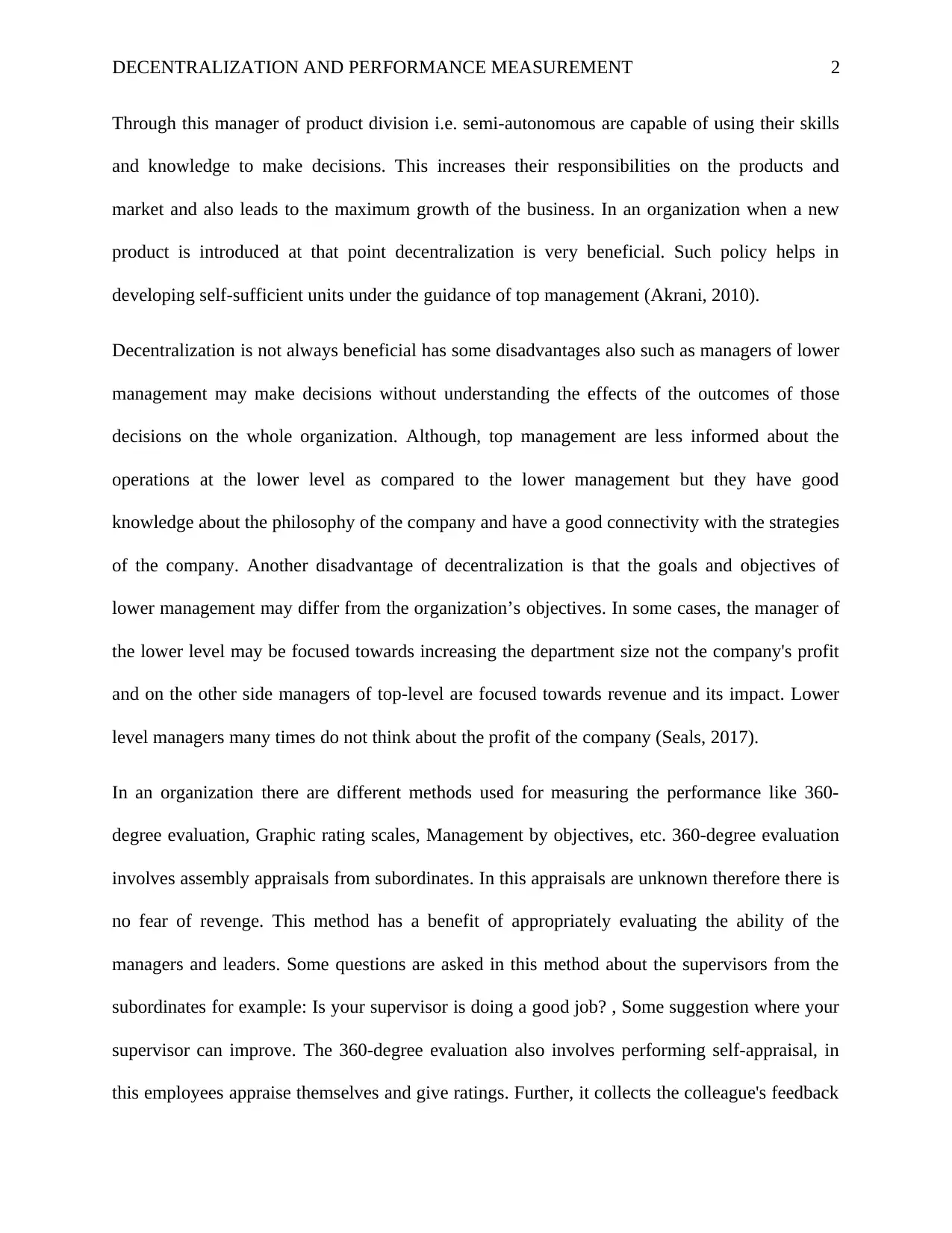
DECENTRALIZATION AND PERFORMANCE MEASUREMENT 2
Through this manager of product division i.e. semi-autonomous are capable of using their skills
and knowledge to make decisions. This increases their responsibilities on the products and
market and also leads to the maximum growth of the business. In an organization when a new
product is introduced at that point decentralization is very beneficial. Such policy helps in
developing self-sufficient units under the guidance of top management (Akrani, 2010).
Decentralization is not always beneficial has some disadvantages also such as managers of lower
management may make decisions without understanding the effects of the outcomes of those
decisions on the whole organization. Although, top management are less informed about the
operations at the lower level as compared to the lower management but they have good
knowledge about the philosophy of the company and have a good connectivity with the strategies
of the company. Another disadvantage of decentralization is that the goals and objectives of
lower management may differ from the organization’s objectives. In some cases, the manager of
the lower level may be focused towards increasing the department size not the company's profit
and on the other side managers of top-level are focused towards revenue and its impact. Lower
level managers many times do not think about the profit of the company (Seals, 2017).
In an organization there are different methods used for measuring the performance like 360-
degree evaluation, Graphic rating scales, Management by objectives, etc. 360-degree evaluation
involves assembly appraisals from subordinates. In this appraisals are unknown therefore there is
no fear of revenge. This method has a benefit of appropriately evaluating the ability of the
managers and leaders. Some questions are asked in this method about the supervisors from the
subordinates for example: Is your supervisor is doing a good job? , Some suggestion where your
supervisor can improve. The 360-degree evaluation also involves performing self-appraisal, in
this employees appraise themselves and give ratings. Further, it collects the colleague's feedback
Through this manager of product division i.e. semi-autonomous are capable of using their skills
and knowledge to make decisions. This increases their responsibilities on the products and
market and also leads to the maximum growth of the business. In an organization when a new
product is introduced at that point decentralization is very beneficial. Such policy helps in
developing self-sufficient units under the guidance of top management (Akrani, 2010).
Decentralization is not always beneficial has some disadvantages also such as managers of lower
management may make decisions without understanding the effects of the outcomes of those
decisions on the whole organization. Although, top management are less informed about the
operations at the lower level as compared to the lower management but they have good
knowledge about the philosophy of the company and have a good connectivity with the strategies
of the company. Another disadvantage of decentralization is that the goals and objectives of
lower management may differ from the organization’s objectives. In some cases, the manager of
the lower level may be focused towards increasing the department size not the company's profit
and on the other side managers of top-level are focused towards revenue and its impact. Lower
level managers many times do not think about the profit of the company (Seals, 2017).
In an organization there are different methods used for measuring the performance like 360-
degree evaluation, Graphic rating scales, Management by objectives, etc. 360-degree evaluation
involves assembly appraisals from subordinates. In this appraisals are unknown therefore there is
no fear of revenge. This method has a benefit of appropriately evaluating the ability of the
managers and leaders. Some questions are asked in this method about the supervisors from the
subordinates for example: Is your supervisor is doing a good job? , Some suggestion where your
supervisor can improve. The 360-degree evaluation also involves performing self-appraisal, in
this employees appraise themselves and give ratings. Further, it collects the colleague's feedback
⊘ This is a preview!⊘
Do you want full access?
Subscribe today to unlock all pages.

Trusted by 1+ million students worldwide
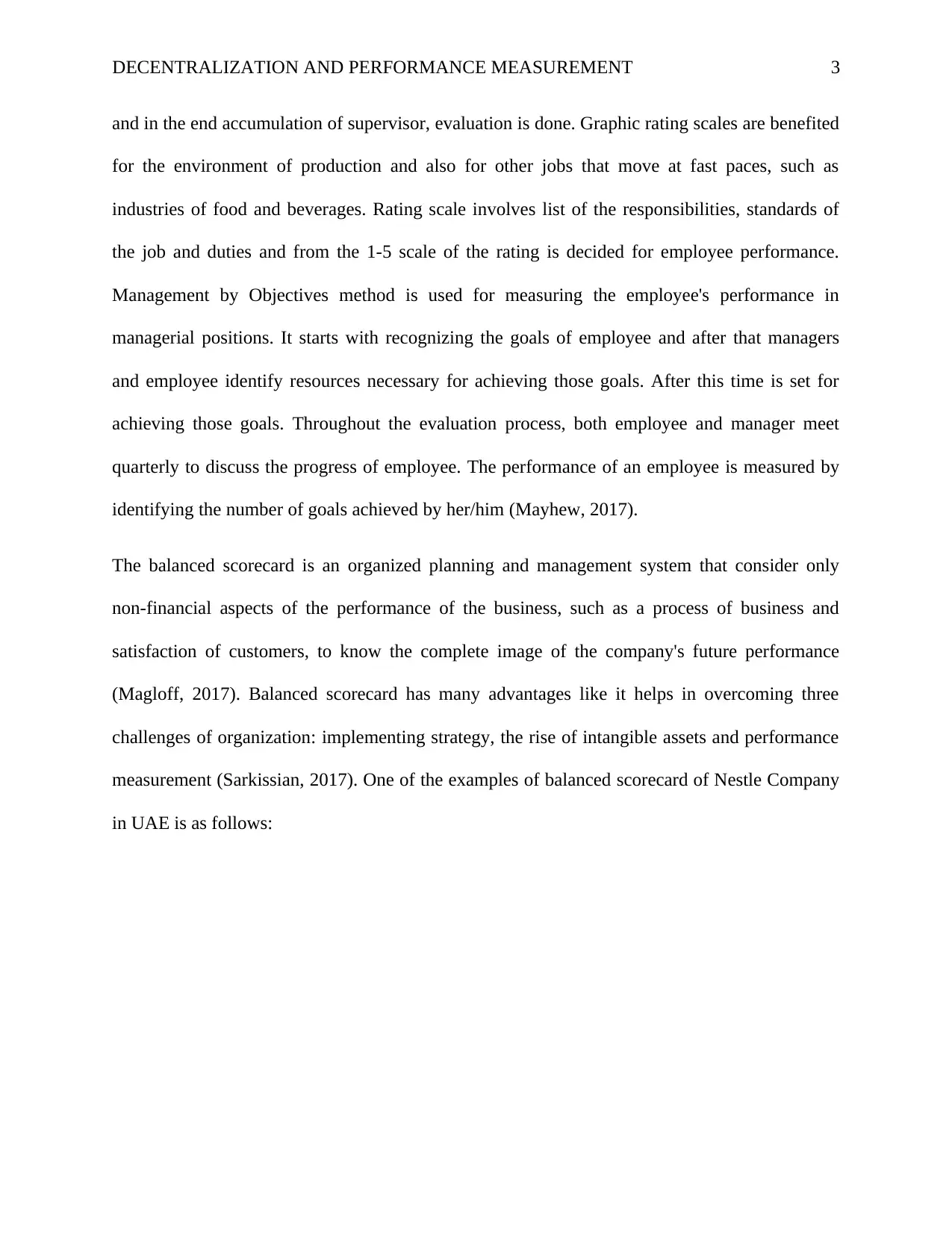
DECENTRALIZATION AND PERFORMANCE MEASUREMENT 3
and in the end accumulation of supervisor, evaluation is done. Graphic rating scales are benefited
for the environment of production and also for other jobs that move at fast paces, such as
industries of food and beverages. Rating scale involves list of the responsibilities, standards of
the job and duties and from the 1-5 scale of the rating is decided for employee performance.
Management by Objectives method is used for measuring the employee's performance in
managerial positions. It starts with recognizing the goals of employee and after that managers
and employee identify resources necessary for achieving those goals. After this time is set for
achieving those goals. Throughout the evaluation process, both employee and manager meet
quarterly to discuss the progress of employee. The performance of an employee is measured by
identifying the number of goals achieved by her/him (Mayhew, 2017).
The balanced scorecard is an organized planning and management system that consider only
non-financial aspects of the performance of the business, such as a process of business and
satisfaction of customers, to know the complete image of the company's future performance
(Magloff, 2017). Balanced scorecard has many advantages like it helps in overcoming three
challenges of organization: implementing strategy, the rise of intangible assets and performance
measurement (Sarkissian, 2017). One of the examples of balanced scorecard of Nestle Company
in UAE is as follows:
and in the end accumulation of supervisor, evaluation is done. Graphic rating scales are benefited
for the environment of production and also for other jobs that move at fast paces, such as
industries of food and beverages. Rating scale involves list of the responsibilities, standards of
the job and duties and from the 1-5 scale of the rating is decided for employee performance.
Management by Objectives method is used for measuring the employee's performance in
managerial positions. It starts with recognizing the goals of employee and after that managers
and employee identify resources necessary for achieving those goals. After this time is set for
achieving those goals. Throughout the evaluation process, both employee and manager meet
quarterly to discuss the progress of employee. The performance of an employee is measured by
identifying the number of goals achieved by her/him (Mayhew, 2017).
The balanced scorecard is an organized planning and management system that consider only
non-financial aspects of the performance of the business, such as a process of business and
satisfaction of customers, to know the complete image of the company's future performance
(Magloff, 2017). Balanced scorecard has many advantages like it helps in overcoming three
challenges of organization: implementing strategy, the rise of intangible assets and performance
measurement (Sarkissian, 2017). One of the examples of balanced scorecard of Nestle Company
in UAE is as follows:
Paraphrase This Document
Need a fresh take? Get an instant paraphrase of this document with our AI Paraphraser
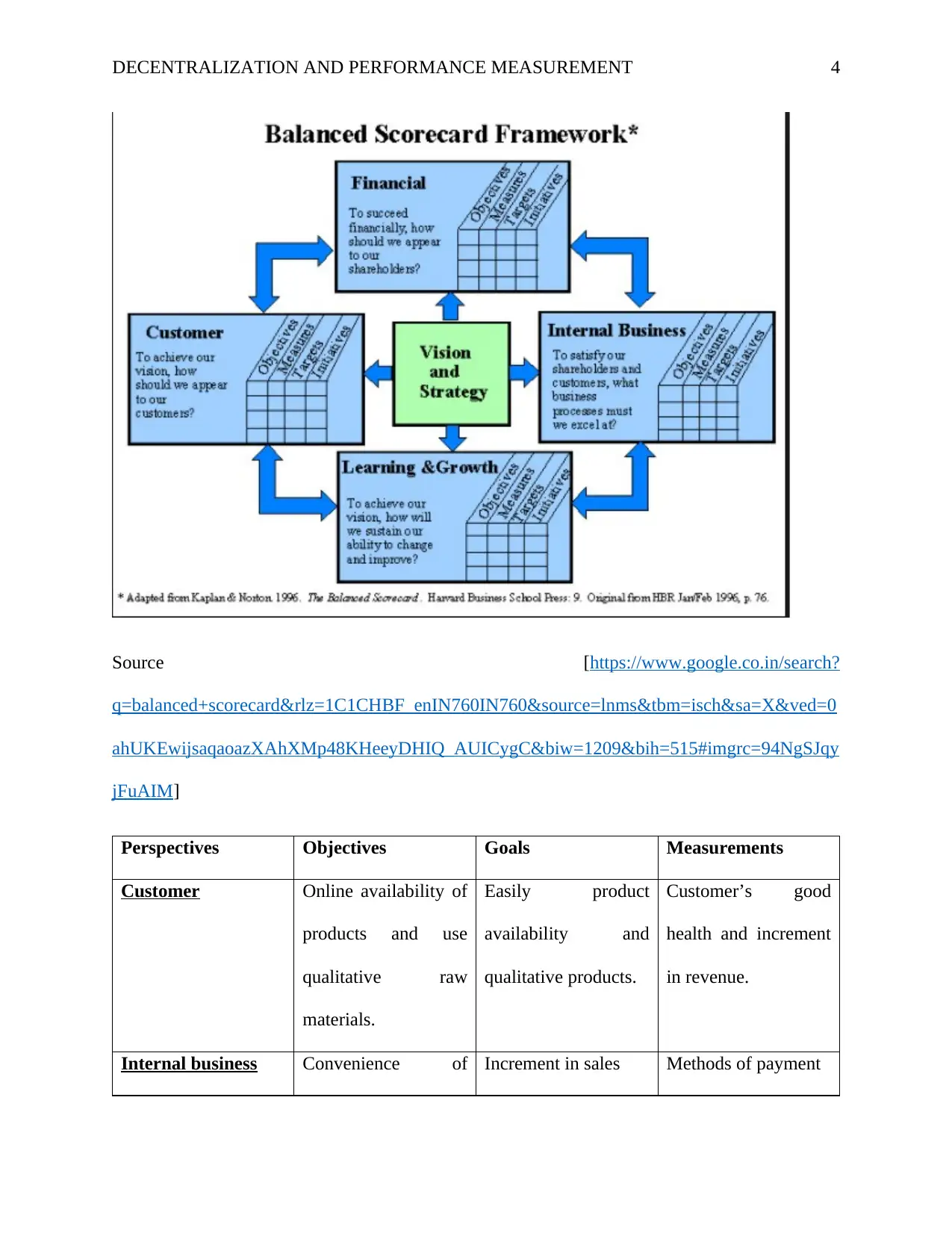
DECENTRALIZATION AND PERFORMANCE MEASUREMENT 4
Source [https://www.google.co.in/search?
q=balanced+scorecard&rlz=1C1CHBF_enIN760IN760&source=lnms&tbm=isch&sa=X&ved=0
ahUKEwijsaqaoazXAhXMp48KHeeyDHIQ_AUICygC&biw=1209&bih=515#imgrc=94NgSJqy
jFuAIM]
Perspectives Objectives Goals Measurements
Customer Online availability of
products and use
qualitative raw
materials.
Easily product
availability and
qualitative products.
Customer’s good
health and increment
in revenue.
Internal business Convenience of Increment in sales Methods of payment
Source [https://www.google.co.in/search?
q=balanced+scorecard&rlz=1C1CHBF_enIN760IN760&source=lnms&tbm=isch&sa=X&ved=0
ahUKEwijsaqaoazXAhXMp48KHeeyDHIQ_AUICygC&biw=1209&bih=515#imgrc=94NgSJqy
jFuAIM]
Perspectives Objectives Goals Measurements
Customer Online availability of
products and use
qualitative raw
materials.
Easily product
availability and
qualitative products.
Customer’s good
health and increment
in revenue.
Internal business Convenience of Increment in sales Methods of payment
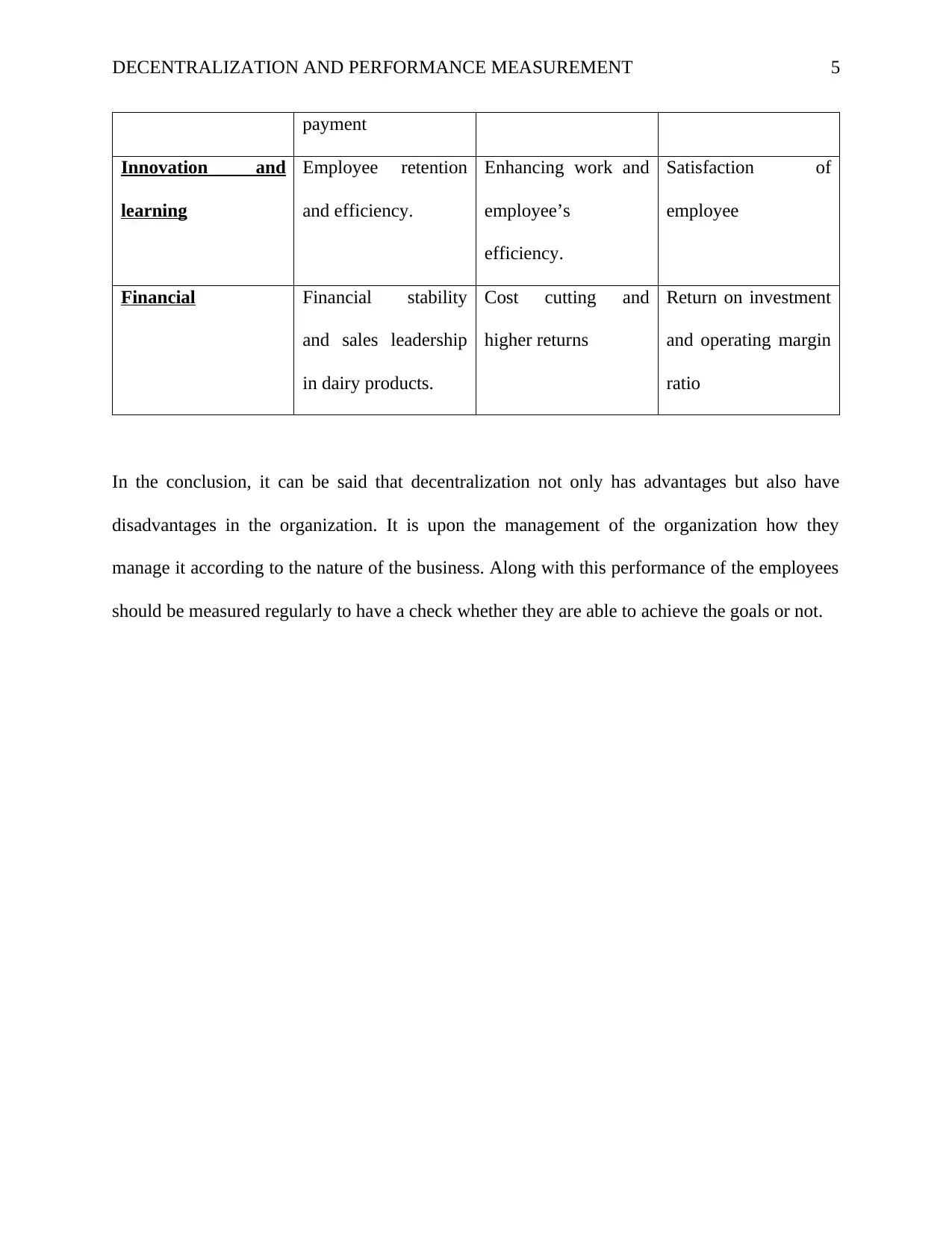
DECENTRALIZATION AND PERFORMANCE MEASUREMENT 5
payment
Innovation and
learning
Employee retention
and efficiency.
Enhancing work and
employee’s
efficiency.
Satisfaction of
employee
Financial Financial stability
and sales leadership
in dairy products.
Cost cutting and
higher returns
Return on investment
and operating margin
ratio
In the conclusion, it can be said that decentralization not only has advantages but also have
disadvantages in the organization. It is upon the management of the organization how they
manage it according to the nature of the business. Along with this performance of the employees
should be measured regularly to have a check whether they are able to achieve the goals or not.
payment
Innovation and
learning
Employee retention
and efficiency.
Enhancing work and
employee’s
efficiency.
Satisfaction of
employee
Financial Financial stability
and sales leadership
in dairy products.
Cost cutting and
higher returns
Return on investment
and operating margin
ratio
In the conclusion, it can be said that decentralization not only has advantages but also have
disadvantages in the organization. It is upon the management of the organization how they
manage it according to the nature of the business. Along with this performance of the employees
should be measured regularly to have a check whether they are able to achieve the goals or not.
⊘ This is a preview!⊘
Do you want full access?
Subscribe today to unlock all pages.

Trusted by 1+ million students worldwide
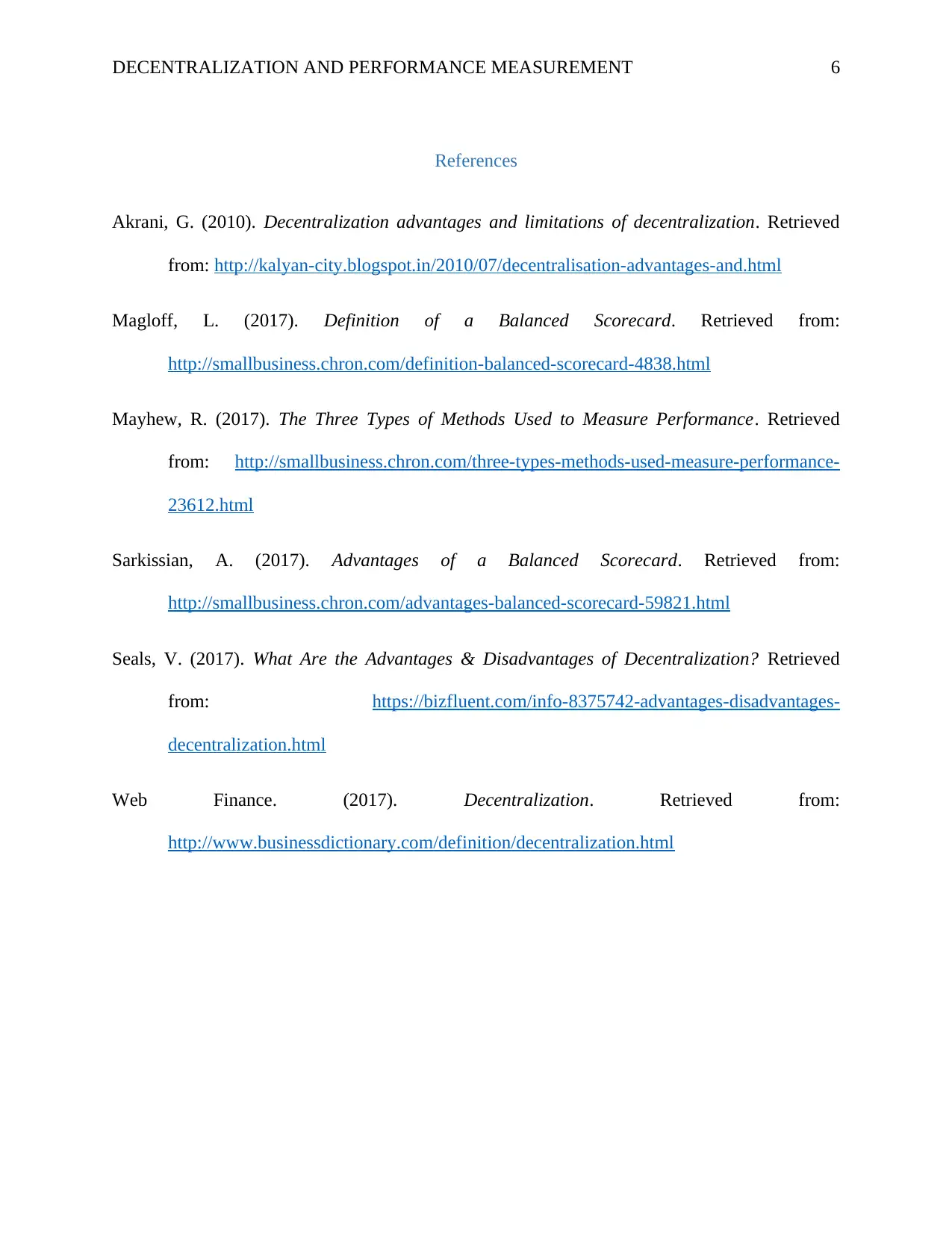
DECENTRALIZATION AND PERFORMANCE MEASUREMENT 6
References
Akrani, G. (2010). Decentralization advantages and limitations of decentralization. Retrieved
from: http://kalyan-city.blogspot.in/2010/07/decentralisation-advantages-and.html
Magloff, L. (2017). Definition of a Balanced Scorecard. Retrieved from:
http://smallbusiness.chron.com/definition-balanced-scorecard-4838.html
Mayhew, R. (2017). The Three Types of Methods Used to Measure Performance. Retrieved
from: http://smallbusiness.chron.com/three-types-methods-used-measure-performance-
23612.html
Sarkissian, A. (2017). Advantages of a Balanced Scorecard. Retrieved from:
http://smallbusiness.chron.com/advantages-balanced-scorecard-59821.html
Seals, V. (2017). What Are the Advantages & Disadvantages of Decentralization? Retrieved
from: https://bizfluent.com/info-8375742-advantages-disadvantages-
decentralization.html
Web Finance. (2017). Decentralization. Retrieved from:
http://www.businessdictionary.com/definition/decentralization.html
References
Akrani, G. (2010). Decentralization advantages and limitations of decentralization. Retrieved
from: http://kalyan-city.blogspot.in/2010/07/decentralisation-advantages-and.html
Magloff, L. (2017). Definition of a Balanced Scorecard. Retrieved from:
http://smallbusiness.chron.com/definition-balanced-scorecard-4838.html
Mayhew, R. (2017). The Three Types of Methods Used to Measure Performance. Retrieved
from: http://smallbusiness.chron.com/three-types-methods-used-measure-performance-
23612.html
Sarkissian, A. (2017). Advantages of a Balanced Scorecard. Retrieved from:
http://smallbusiness.chron.com/advantages-balanced-scorecard-59821.html
Seals, V. (2017). What Are the Advantages & Disadvantages of Decentralization? Retrieved
from: https://bizfluent.com/info-8375742-advantages-disadvantages-
decentralization.html
Web Finance. (2017). Decentralization. Retrieved from:
http://www.businessdictionary.com/definition/decentralization.html
1 out of 7
Related Documents
Your All-in-One AI-Powered Toolkit for Academic Success.
+13062052269
info@desklib.com
Available 24*7 on WhatsApp / Email
![[object Object]](/_next/static/media/star-bottom.7253800d.svg)
Unlock your academic potential
Copyright © 2020–2025 A2Z Services. All Rights Reserved. Developed and managed by ZUCOL.





